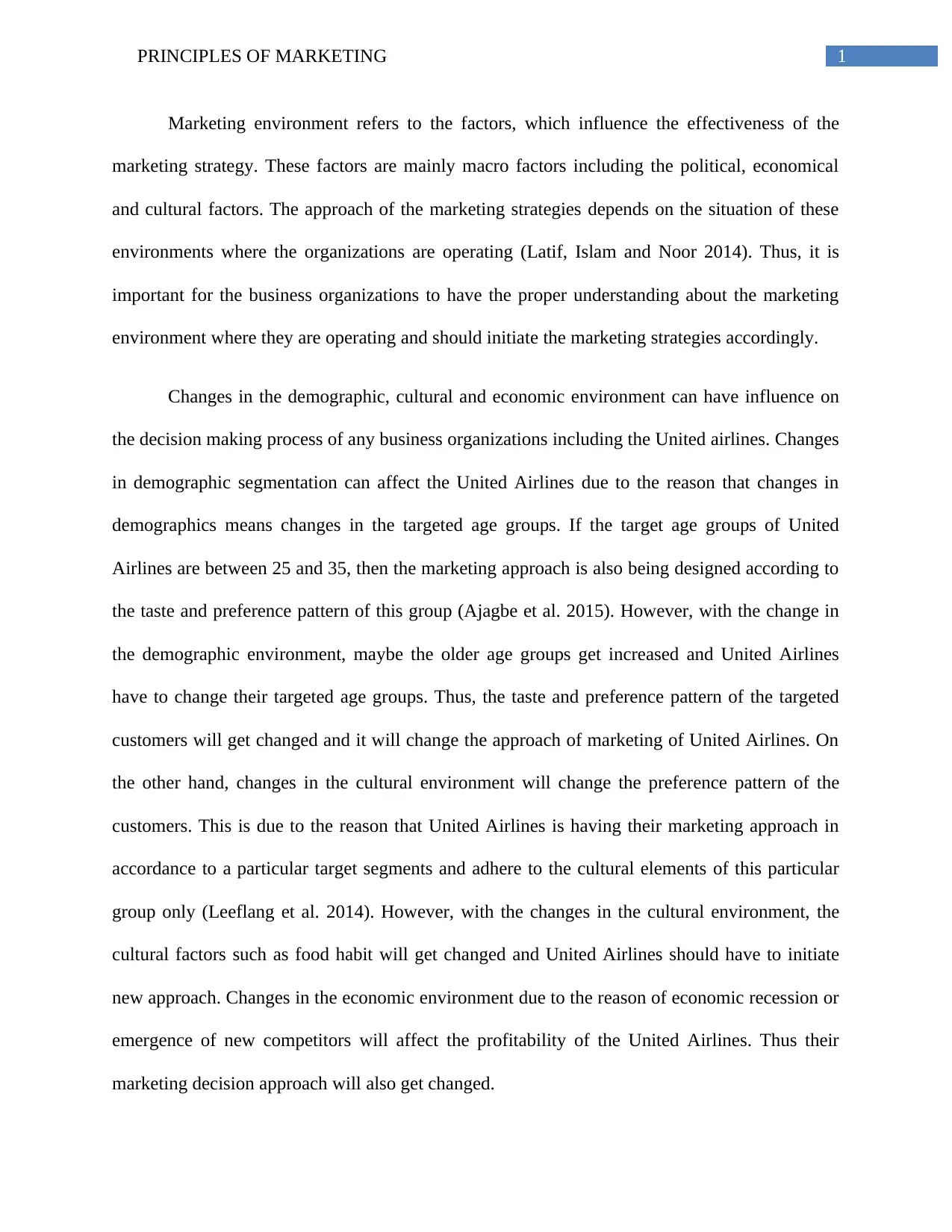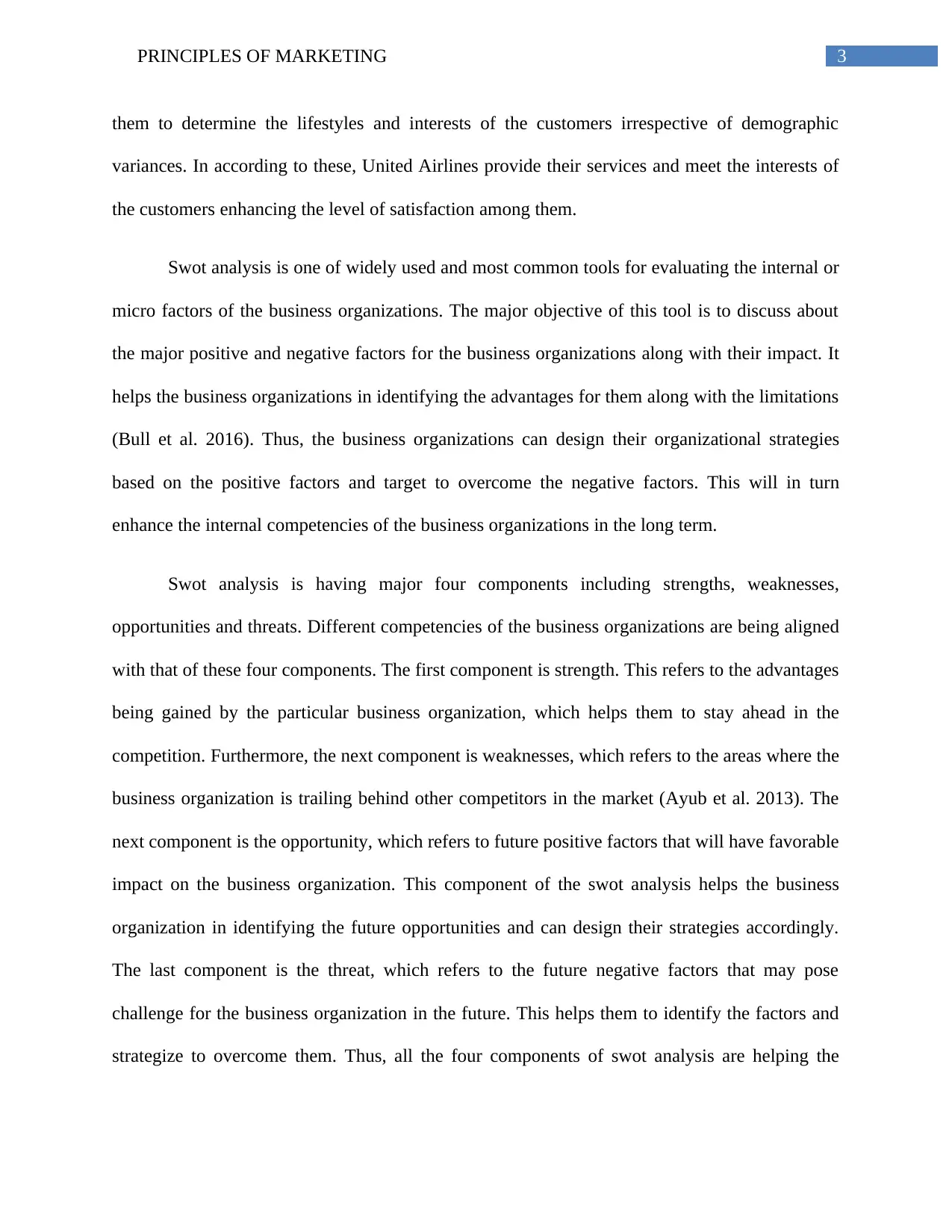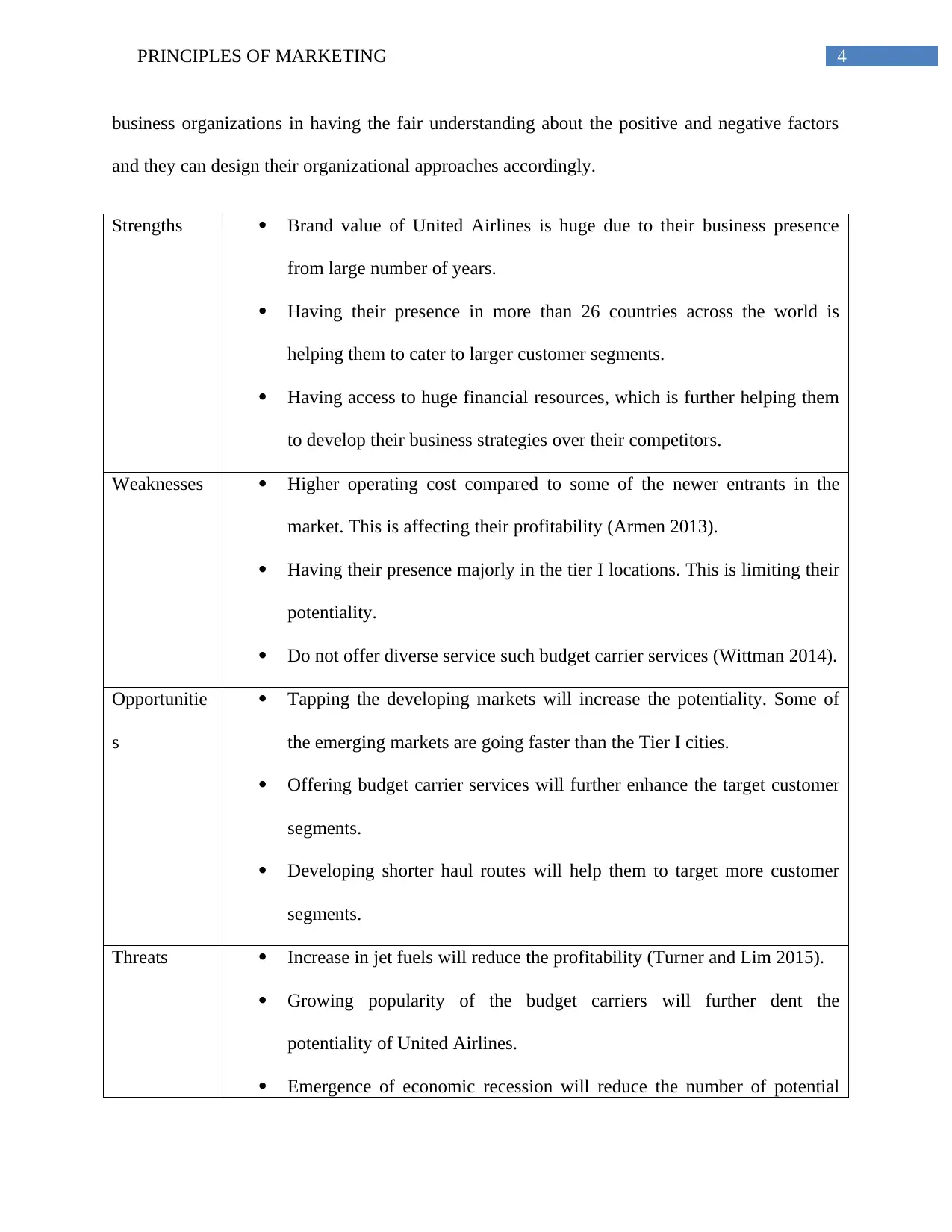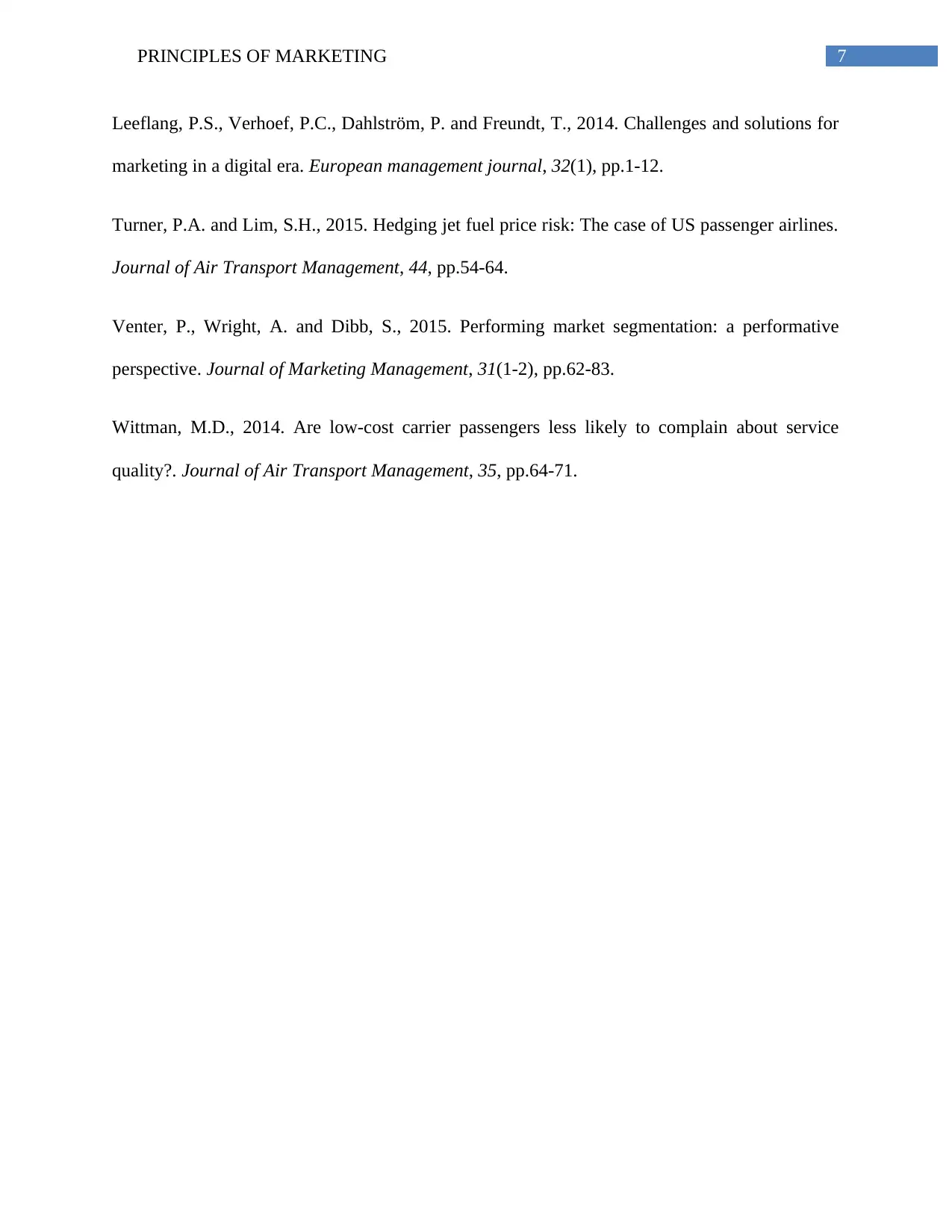BE200 Marketing: Analyzing United Airlines' Environment & Strategies
VerifiedAdded on 2023/05/30
|8
|1747
|164
Essay
AI Summary
This essay provides an analysis of United Airlines' marketing strategies, focusing on the marketing environment, market segmentation, and SWOT analysis. It discusses how changes in demographic, cultural, and economic environments influence United Airlines' decision-making process. The essay also explores the airline's use of psychographic segmentation and evaluates its strengths, weaknesses, opportunities, and threats. The SWOT analysis highlights the airline's brand value, global presence, and financial resources as strengths, while higher operating costs and limited presence in tier II locations are identified as weaknesses. Opportunities include tapping into developing markets and offering budget carrier services, while threats include increased jet fuel prices and the growing popularity of budget carriers. This analysis helps in understanding the strategic challenges and opportunities facing United Airlines in the competitive airline industry.

Running head: PRINCIPLES OF MARKETING
Principles of marketing
Name of the student
Name of the university
Author note
Principles of marketing
Name of the student
Name of the university
Author note
Paraphrase This Document
Need a fresh take? Get an instant paraphrase of this document with our AI Paraphraser

1PRINCIPLES OF MARKETING
Marketing environment refers to the factors, which influence the effectiveness of the
marketing strategy. These factors are mainly macro factors including the political, economical
and cultural factors. The approach of the marketing strategies depends on the situation of these
environments where the organizations are operating (Latif, Islam and Noor 2014). Thus, it is
important for the business organizations to have the proper understanding about the marketing
environment where they are operating and should initiate the marketing strategies accordingly.
Changes in the demographic, cultural and economic environment can have influence on
the decision making process of any business organizations including the United airlines. Changes
in demographic segmentation can affect the United Airlines due to the reason that changes in
demographics means changes in the targeted age groups. If the target age groups of United
Airlines are between 25 and 35, then the marketing approach is also being designed according to
the taste and preference pattern of this group (Ajagbe et al. 2015). However, with the change in
the demographic environment, maybe the older age groups get increased and United Airlines
have to change their targeted age groups. Thus, the taste and preference pattern of the targeted
customers will get changed and it will change the approach of marketing of United Airlines. On
the other hand, changes in the cultural environment will change the preference pattern of the
customers. This is due to the reason that United Airlines is having their marketing approach in
accordance to a particular target segments and adhere to the cultural elements of this particular
group only (Leeflang et al. 2014). However, with the changes in the cultural environment, the
cultural factors such as food habit will get changed and United Airlines should have to initiate
new approach. Changes in the economic environment due to the reason of economic recession or
emergence of new competitors will affect the profitability of the United Airlines. Thus their
marketing decision approach will also get changed.
Marketing environment refers to the factors, which influence the effectiveness of the
marketing strategy. These factors are mainly macro factors including the political, economical
and cultural factors. The approach of the marketing strategies depends on the situation of these
environments where the organizations are operating (Latif, Islam and Noor 2014). Thus, it is
important for the business organizations to have the proper understanding about the marketing
environment where they are operating and should initiate the marketing strategies accordingly.
Changes in the demographic, cultural and economic environment can have influence on
the decision making process of any business organizations including the United airlines. Changes
in demographic segmentation can affect the United Airlines due to the reason that changes in
demographics means changes in the targeted age groups. If the target age groups of United
Airlines are between 25 and 35, then the marketing approach is also being designed according to
the taste and preference pattern of this group (Ajagbe et al. 2015). However, with the change in
the demographic environment, maybe the older age groups get increased and United Airlines
have to change their targeted age groups. Thus, the taste and preference pattern of the targeted
customers will get changed and it will change the approach of marketing of United Airlines. On
the other hand, changes in the cultural environment will change the preference pattern of the
customers. This is due to the reason that United Airlines is having their marketing approach in
accordance to a particular target segments and adhere to the cultural elements of this particular
group only (Leeflang et al. 2014). However, with the changes in the cultural environment, the
cultural factors such as food habit will get changed and United Airlines should have to initiate
new approach. Changes in the economic environment due to the reason of economic recession or
emergence of new competitors will affect the profitability of the United Airlines. Thus their
marketing decision approach will also get changed.

2PRINCIPLES OF MARKETING
Market segmentation is the process of classifying the entire market in different sub
groups in terms of different variables. This helps the business organizations in short listing the
target customers in accordance to the approach of the organizations. In the current business
scenario, customers are more diverse in nature with having different social and cultural variables
(Cross, Belich and Rudelius 2015). Thus, it is difficult for the contemporary business
organizations to meet the diverse requirements and expectations of the customers with their
respective products or services. In this case, market segmentation helps them to divide the
markets and target only those, which are getting matched with characteristics of the business
organizations.
Market segments refer to the target customer groups, which are the classified sub groups
of the entire market. Market segments are being selected based on different variables such as
demographic, psychographic, behavioral and geographic. Among the all the target customers
available for the business organizations, business organizations select only the particular target
segments for targeting them in the further stage (Venter, Wright and Dibb 2015).
Targeting is the secondary step being initiated by the business organizations after
segmenting the customer groups. This refers to the process of initiating generic strategies for the
particular target segments to attract them towards their service or product (Haenlein and Libai
2013). Positioning is the last step, which refers to the process of placing the product in the
market on the basis of a particular competitiveness. This helps to create a particular brand recall
value among the customers.
United Airlines mainly used the psychographic segmentation for their business growth.
This is due to the reason that customer segmentation through the psychographic variables helps
Market segmentation is the process of classifying the entire market in different sub
groups in terms of different variables. This helps the business organizations in short listing the
target customers in accordance to the approach of the organizations. In the current business
scenario, customers are more diverse in nature with having different social and cultural variables
(Cross, Belich and Rudelius 2015). Thus, it is difficult for the contemporary business
organizations to meet the diverse requirements and expectations of the customers with their
respective products or services. In this case, market segmentation helps them to divide the
markets and target only those, which are getting matched with characteristics of the business
organizations.
Market segments refer to the target customer groups, which are the classified sub groups
of the entire market. Market segments are being selected based on different variables such as
demographic, psychographic, behavioral and geographic. Among the all the target customers
available for the business organizations, business organizations select only the particular target
segments for targeting them in the further stage (Venter, Wright and Dibb 2015).
Targeting is the secondary step being initiated by the business organizations after
segmenting the customer groups. This refers to the process of initiating generic strategies for the
particular target segments to attract them towards their service or product (Haenlein and Libai
2013). Positioning is the last step, which refers to the process of placing the product in the
market on the basis of a particular competitiveness. This helps to create a particular brand recall
value among the customers.
United Airlines mainly used the psychographic segmentation for their business growth.
This is due to the reason that customer segmentation through the psychographic variables helps
⊘ This is a preview!⊘
Do you want full access?
Subscribe today to unlock all pages.

Trusted by 1+ million students worldwide

3PRINCIPLES OF MARKETING
them to determine the lifestyles and interests of the customers irrespective of demographic
variances. In according to these, United Airlines provide their services and meet the interests of
the customers enhancing the level of satisfaction among them.
Swot analysis is one of widely used and most common tools for evaluating the internal or
micro factors of the business organizations. The major objective of this tool is to discuss about
the major positive and negative factors for the business organizations along with their impact. It
helps the business organizations in identifying the advantages for them along with the limitations
(Bull et al. 2016). Thus, the business organizations can design their organizational strategies
based on the positive factors and target to overcome the negative factors. This will in turn
enhance the internal competencies of the business organizations in the long term.
Swot analysis is having major four components including strengths, weaknesses,
opportunities and threats. Different competencies of the business organizations are being aligned
with that of these four components. The first component is strength. This refers to the advantages
being gained by the particular business organization, which helps them to stay ahead in the
competition. Furthermore, the next component is weaknesses, which refers to the areas where the
business organization is trailing behind other competitors in the market (Ayub et al. 2013). The
next component is the opportunity, which refers to future positive factors that will have favorable
impact on the business organization. This component of the swot analysis helps the business
organization in identifying the future opportunities and can design their strategies accordingly.
The last component is the threat, which refers to the future negative factors that may pose
challenge for the business organization in the future. This helps them to identify the factors and
strategize to overcome them. Thus, all the four components of swot analysis are helping the
them to determine the lifestyles and interests of the customers irrespective of demographic
variances. In according to these, United Airlines provide their services and meet the interests of
the customers enhancing the level of satisfaction among them.
Swot analysis is one of widely used and most common tools for evaluating the internal or
micro factors of the business organizations. The major objective of this tool is to discuss about
the major positive and negative factors for the business organizations along with their impact. It
helps the business organizations in identifying the advantages for them along with the limitations
(Bull et al. 2016). Thus, the business organizations can design their organizational strategies
based on the positive factors and target to overcome the negative factors. This will in turn
enhance the internal competencies of the business organizations in the long term.
Swot analysis is having major four components including strengths, weaknesses,
opportunities and threats. Different competencies of the business organizations are being aligned
with that of these four components. The first component is strength. This refers to the advantages
being gained by the particular business organization, which helps them to stay ahead in the
competition. Furthermore, the next component is weaknesses, which refers to the areas where the
business organization is trailing behind other competitors in the market (Ayub et al. 2013). The
next component is the opportunity, which refers to future positive factors that will have favorable
impact on the business organization. This component of the swot analysis helps the business
organization in identifying the future opportunities and can design their strategies accordingly.
The last component is the threat, which refers to the future negative factors that may pose
challenge for the business organization in the future. This helps them to identify the factors and
strategize to overcome them. Thus, all the four components of swot analysis are helping the
Paraphrase This Document
Need a fresh take? Get an instant paraphrase of this document with our AI Paraphraser

4PRINCIPLES OF MARKETING
business organizations in having the fair understanding about the positive and negative factors
and they can design their organizational approaches accordingly.
Strengths Brand value of United Airlines is huge due to their business presence
from large number of years.
Having their presence in more than 26 countries across the world is
helping them to cater to larger customer segments.
Having access to huge financial resources, which is further helping them
to develop their business strategies over their competitors.
Weaknesses Higher operating cost compared to some of the newer entrants in the
market. This is affecting their profitability (Armen 2013).
Having their presence majorly in the tier I locations. This is limiting their
potentiality.
Do not offer diverse service such budget carrier services (Wittman 2014).
Opportunitie
s
Tapping the developing markets will increase the potentiality. Some of
the emerging markets are going faster than the Tier I cities.
Offering budget carrier services will further enhance the target customer
segments.
Developing shorter haul routes will help them to target more customer
segments.
Threats Increase in jet fuels will reduce the profitability (Turner and Lim 2015).
Growing popularity of the budget carriers will further dent the
potentiality of United Airlines.
Emergence of economic recession will reduce the number of potential
business organizations in having the fair understanding about the positive and negative factors
and they can design their organizational approaches accordingly.
Strengths Brand value of United Airlines is huge due to their business presence
from large number of years.
Having their presence in more than 26 countries across the world is
helping them to cater to larger customer segments.
Having access to huge financial resources, which is further helping them
to develop their business strategies over their competitors.
Weaknesses Higher operating cost compared to some of the newer entrants in the
market. This is affecting their profitability (Armen 2013).
Having their presence majorly in the tier I locations. This is limiting their
potentiality.
Do not offer diverse service such budget carrier services (Wittman 2014).
Opportunitie
s
Tapping the developing markets will increase the potentiality. Some of
the emerging markets are going faster than the Tier I cities.
Offering budget carrier services will further enhance the target customer
segments.
Developing shorter haul routes will help them to target more customer
segments.
Threats Increase in jet fuels will reduce the profitability (Turner and Lim 2015).
Growing popularity of the budget carriers will further dent the
potentiality of United Airlines.
Emergence of economic recession will reduce the number of potential

5PRINCIPLES OF MARKETING
customers.
customers.
⊘ This is a preview!⊘
Do you want full access?
Subscribe today to unlock all pages.

Trusted by 1+ million students worldwide

6PRINCIPLES OF MARKETING
Reference
Ajagbe, A.M., Ogbari, M.E., Oke, A.O. and Isiavwe, D.T., 2015. Review of global marketing
environment and entrepreneurship development. International Journal of Commerce and Law,
pp.1-14.
Armen, S., 2013. Performance assessment of major US airlines via cash flow ratios. Annals of
the University of Oradea, Economic Science Series, 22(2), pp.p398-408.
Ayub, A., Razzaq, A., Aslam, M.S. and Iftekhar, H., 2013. A conceptual framework on
evaluating SWOT analysis as the mediator in strategic marketing planning through marketing
intelligence. European Journal of Business and Social Sciences, 2(1), pp.91-98.
Bull, J.W., Jobstvogt, N., Böhnke-Henrichs, A., Mascarenhas, A., Sitas, N., Baulcomb, C.,
Lambini, C.K., Rawlins, M., Baral, H., Zähringer, J. and Carter-Silk, E., 2016. Strengths,
Weaknesses, Opportunities and Threats: A SWOT analysis of the ecosystem services framework.
Ecosystem Services, 17, pp.99-111.
Cross, J.C., Belich, T.J. and Rudelius, W., 2015. How marketing managers use market
segmentation: An exploratory study. In Proceedings of the 1990 Academy of Marketing Science
(AMS) Annual Conference (pp. 531-536). Springer, Cham.
Haenlein, M. and Libai, B., 2013. Targeting revenue leaders for a new product. Journal of
Marketing, 77(3), pp.65-80.
Latif, W.B., Islam, M.A. and Noor, I.B.M., 2014. A conceptual framework to build brand loyalty
in the modern marketing environment. Journal of Asian Scientific Research, 4(10), p.547.
Reference
Ajagbe, A.M., Ogbari, M.E., Oke, A.O. and Isiavwe, D.T., 2015. Review of global marketing
environment and entrepreneurship development. International Journal of Commerce and Law,
pp.1-14.
Armen, S., 2013. Performance assessment of major US airlines via cash flow ratios. Annals of
the University of Oradea, Economic Science Series, 22(2), pp.p398-408.
Ayub, A., Razzaq, A., Aslam, M.S. and Iftekhar, H., 2013. A conceptual framework on
evaluating SWOT analysis as the mediator in strategic marketing planning through marketing
intelligence. European Journal of Business and Social Sciences, 2(1), pp.91-98.
Bull, J.W., Jobstvogt, N., Böhnke-Henrichs, A., Mascarenhas, A., Sitas, N., Baulcomb, C.,
Lambini, C.K., Rawlins, M., Baral, H., Zähringer, J. and Carter-Silk, E., 2016. Strengths,
Weaknesses, Opportunities and Threats: A SWOT analysis of the ecosystem services framework.
Ecosystem Services, 17, pp.99-111.
Cross, J.C., Belich, T.J. and Rudelius, W., 2015. How marketing managers use market
segmentation: An exploratory study. In Proceedings of the 1990 Academy of Marketing Science
(AMS) Annual Conference (pp. 531-536). Springer, Cham.
Haenlein, M. and Libai, B., 2013. Targeting revenue leaders for a new product. Journal of
Marketing, 77(3), pp.65-80.
Latif, W.B., Islam, M.A. and Noor, I.B.M., 2014. A conceptual framework to build brand loyalty
in the modern marketing environment. Journal of Asian Scientific Research, 4(10), p.547.
Paraphrase This Document
Need a fresh take? Get an instant paraphrase of this document with our AI Paraphraser

7PRINCIPLES OF MARKETING
Leeflang, P.S., Verhoef, P.C., Dahlström, P. and Freundt, T., 2014. Challenges and solutions for
marketing in a digital era. European management journal, 32(1), pp.1-12.
Turner, P.A. and Lim, S.H., 2015. Hedging jet fuel price risk: The case of US passenger airlines.
Journal of Air Transport Management, 44, pp.54-64.
Venter, P., Wright, A. and Dibb, S., 2015. Performing market segmentation: a performative
perspective. Journal of Marketing Management, 31(1-2), pp.62-83.
Wittman, M.D., 2014. Are low-cost carrier passengers less likely to complain about service
quality?. Journal of Air Transport Management, 35, pp.64-71.
Leeflang, P.S., Verhoef, P.C., Dahlström, P. and Freundt, T., 2014. Challenges and solutions for
marketing in a digital era. European management journal, 32(1), pp.1-12.
Turner, P.A. and Lim, S.H., 2015. Hedging jet fuel price risk: The case of US passenger airlines.
Journal of Air Transport Management, 44, pp.54-64.
Venter, P., Wright, A. and Dibb, S., 2015. Performing market segmentation: a performative
perspective. Journal of Marketing Management, 31(1-2), pp.62-83.
Wittman, M.D., 2014. Are low-cost carrier passengers less likely to complain about service
quality?. Journal of Air Transport Management, 35, pp.64-71.
1 out of 8
Related Documents
Your All-in-One AI-Powered Toolkit for Academic Success.
+13062052269
info@desklib.com
Available 24*7 on WhatsApp / Email
![[object Object]](/_next/static/media/star-bottom.7253800d.svg)
Unlock your academic potential
Copyright © 2020–2025 A2Z Services. All Rights Reserved. Developed and managed by ZUCOL.




